Reinvestigation of the dysbindin subunit of BLOC-1 (biogenesis of lysosome-related organelles complex-1) as a dystrobrevin-binding protein
- PMID: 16448387
- PMCID: PMC1462696
- DOI: 10.1042/BJ20051965
Reinvestigation of the dysbindin subunit of BLOC-1 (biogenesis of lysosome-related organelles complex-1) as a dystrobrevin-binding protein
Abstract
Dysbindin was identified as a dystrobrevin-binding protein potentially involved in the pathogenesis of muscular dystrophy. Subsequently, genetic studies have implicated variants of the human dysbindin-encoding gene, DTNBP1, in the pathogeneses of Hermansky-Pudlak syndrome and schizophrenia. The protein is a stable component of a multisubunit complex termed BLOC-1 (biogenesis of lysosome-related organelles complex-1). In the present study, the significance of the dystrobrevin-dysbindin interaction for BLOC-1 function was examined. Yeast two-hybrid analyses, and binding assays using recombinant proteins, demonstrated direct interaction involving coiled-coil-forming regions in both dysbindin and the dystrobrevins. However, recombinant proteins bearing the coiled-coil-forming regions of the dystrobrevins failed to bind endogenous BLOC-1 from HeLa cells or mouse brain or muscle, under conditions in which they bound the Dp71 isoform of dystrophin. Immunoprecipitation of endogenous dysbindin from brain or muscle resulted in robust co-immunoprecipitation of the pallidin subunit of BLOC-1 but no specific co-immunoprecipitation of dystrobrevin isoforms. Within BLOC-1, dysbindin is engaged in interactions with three other subunits, named pallidin, snapin and muted. We herein provide evidence that the same 69-residue region of dysbindin that is sufficient for dystrobrevin binding in vitro also contains the binding sites for pallidin and snapin, and at least part of the muted-binding interface. Functional, histological and immunohistochemical analyses failed to detect any sign of muscle pathology in BLOC-1-deficient, homozygous pallid mice. Taken together, these results suggest that dysbindin assembled into BLOC-1 is not a physiological binding partner of the dystrobrevins, likely due to engagement of its dystrobrevin-binding region in interactions with other subunits.
Figures
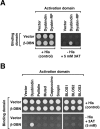

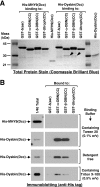
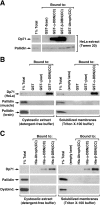
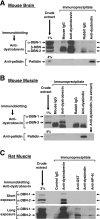
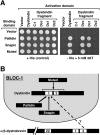
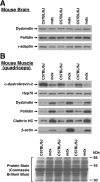

Similar articles
-
Dysbindin-containing complexes and their proposed functions in brain: from zero to (too) many in a decade.ASN Neuro. 2011 May 27;3(2):e00058. doi: 10.1042/AN20110010. ASN Neuro. 2011. PMID: 21504412 Free PMC article. Review.
-
Identification of snapin and three novel proteins (BLOS1, BLOS2, and BLOS3/reduced pigmentation) as subunits of biogenesis of lysosome-related organelles complex-1 (BLOC-1).J Biol Chem. 2004 Jul 2;279(27):28393-401. doi: 10.1074/jbc.M402513200. Epub 2004 Apr 21. J Biol Chem. 2004. PMID: 15102850
-
Recognition deficits in mice carrying mutations of genes encoding BLOC-1 subunits pallidin or dysbindin.Genes Brain Behav. 2015 Nov;14(8):618-24. doi: 10.1111/gbb.12240. Epub 2015 Sep 10. Genes Brain Behav. 2015. PMID: 26294018
-
Hermansky-Pudlak syndrome type 7 (HPS-7) results from mutant dysbindin, a member of the biogenesis of lysosome-related organelles complex 1 (BLOC-1).Nat Genet. 2003 Sep;35(1):84-9. doi: 10.1038/ng1229. Epub 2003 Aug 17. Nat Genet. 2003. PMID: 12923531 Free PMC article.
-
Dystrobrevins in muscle and non-muscle tissues.Neuromuscul Disord. 2007 Feb;17(2):123-34. doi: 10.1016/j.nmd.2006.11.003. Epub 2007 Jan 23. Neuromuscul Disord. 2007. PMID: 17251025 Review.
Cited by
-
Apoptotic signalling targets the post-endocytic sorting machinery of the death receptor Fas/CD95.Nat Commun. 2019 Jul 15;10(1):3105. doi: 10.1038/s41467-019-11025-y. Nat Commun. 2019. PMID: 31308371 Free PMC article.
-
Pallidin protein in neurodevelopment and its relation to the pathogenesis of schizophrenia.Mol Med Rep. 2017 Feb;15(2):665-672. doi: 10.3892/mmr.2016.6064. Epub 2016 Dec 21. Mol Med Rep. 2017. PMID: 28035416 Free PMC article.
-
Dysbindin-containing complexes and their proposed functions in brain: from zero to (too) many in a decade.ASN Neuro. 2011 May 27;3(2):e00058. doi: 10.1042/AN20110010. ASN Neuro. 2011. PMID: 21504412 Free PMC article. Review.
-
Disorders of lysosome-related organelle biogenesis: clinical and molecular genetics.Annu Rev Genomics Hum Genet. 2008;9:359-86. doi: 10.1146/annurev.genom.9.081307.164303. Annu Rev Genomics Hum Genet. 2008. PMID: 18544035 Free PMC article. Review.
-
Recurrent rhabdomyolysis in a patient with oculocutaneous albinism type 1 and platelet storage-pool deficiency.Am J Med Genet A. 2008 Dec 1;146A(23):3100-3. doi: 10.1002/ajmg.a.32569. Am J Med Genet A. 2008. PMID: 19006216 Free PMC article. No abstract available.
References
-
- Blake D. J., Weir A., Newey S. E., Davies K. E. Function and genetics of dystrophin and dystrophin-related proteins in muscle. Physiol. Rev. 2002;82:291–329. - PubMed
-
- Albrecht D. E., Froehner S. C. Syntrophins and dystrobrevins: defining the dystrophin scaffold at synapses. Neurosignals. 2002;11:123–129. - PubMed
-
- Durbeej M., Campbell K. P. Muscular dystrophies involving the dystrophin–glycoprotein complex: an overview of current mouse models. Curr. Opin. Genet. Dev. 2002;12:349–361. - PubMed
-
- Blake D. J. Dystrobrevin dynamics in muscle-cell signaling: a possible target for therapeutic intervention in Duchenne muscular dystrophy? Neuromuscul. Disord. 2002;12:S110–S117. - PubMed
-
- Grady R. M., Grange R. W., Lau K. S., Maimone M. M., Nichol M. C., Stull J. T., Sanes J. R. Role for α-dystrobrevin in the pathogenesis of dystrophin-dependent muscular dystrophies. Nat. Cell Biol. 1999;1:215–220. - PubMed
Publication types
MeSH terms
Substances
Associated data
- Actions
Grants and funding
LinkOut - more resources
Full Text Sources
Molecular Biology Databases

